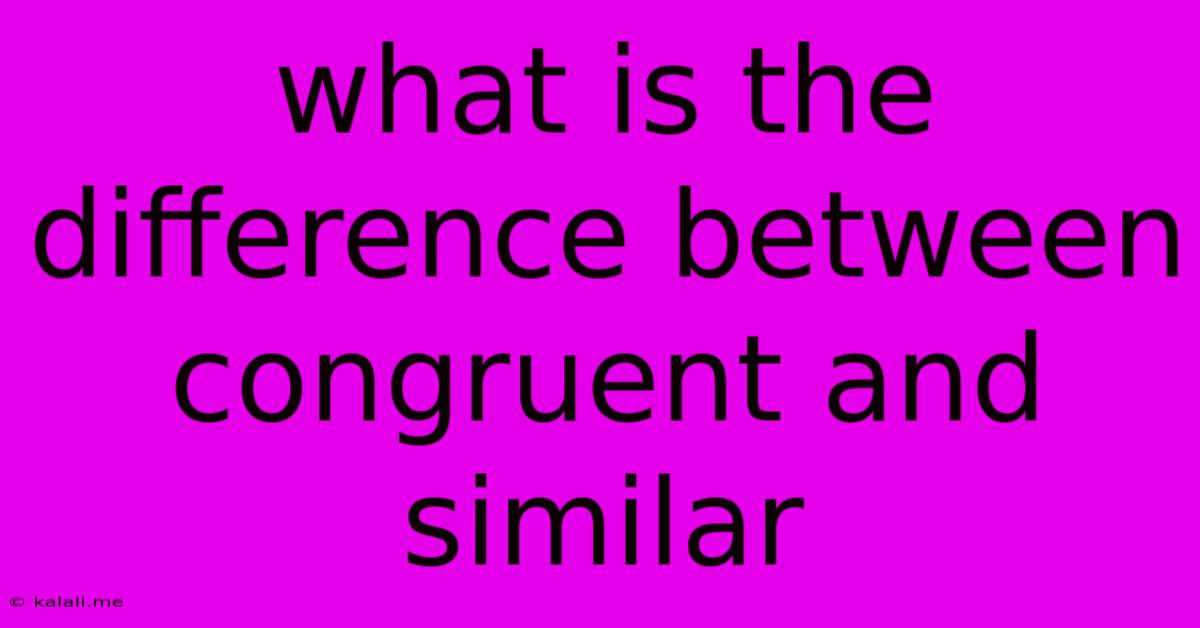What Is The Difference Between Congruent And Similar
Kalali
May 10, 2025 · 2 min read

Table of Contents
Congruent vs. Similar: Understanding the Key Differences in Geometry
This article explores the core differences between congruent and similar shapes in geometry. Understanding these concepts is crucial for anyone studying geometry, from middle school students to advanced mathematicians. We'll delve into the definitions, explore examples, and highlight the key distinctions to ensure a clear understanding.
What does congruent mean? Congruent shapes are identical in size and shape. Think of them as perfect copies of each other. If you could pick up one shape and place it exactly on top of another, with all sides and angles matching perfectly, then the shapes are congruent. This means corresponding sides and angles have equal measures. Congruence is often denoted by the symbol ≅.
What are the properties of congruent shapes?
- Equal Corresponding Sides: All corresponding sides have the same length.
- Equal Corresponding Angles: All corresponding angles have the same measure.
- Same Shape and Size: The overall shape and size are identical.
What does similar mean? Similar shapes have the same shape but different sizes. Imagine enlarging or shrinking a photograph – the resulting image is similar to the original; it retains the same proportions but is scaled differently. This means corresponding angles are equal, but corresponding sides are proportional. Similarity is often denoted by the symbol ~.
What are the properties of similar shapes?
- Equal Corresponding Angles: All corresponding angles have the same measure.
- Proportional Corresponding Sides: Corresponding sides have lengths that are in the same ratio. This ratio is called the scale factor.
Key Differences Summarized:
| Feature | Congruent Shapes | Similar Shapes |
|---|---|---|
| Size | Identical | Different |
| Shape | Identical | Identical |
| Corresponding Sides | Equal | Proportional |
| Corresponding Angles | Equal | Equal |
| Scale Factor | 1 (no scaling) | Greater than or less than 1 |
Examples:
- Congruent: Two squares with side lengths of 5 cm are congruent. Two equilateral triangles with sides of 10 inches each are congruent.
- Similar: A small triangle with angles 30°, 60°, and 90° is similar to a larger triangle with the same angles. A map is a similar representation of a larger geographical area.
Real-World Applications:
Understanding congruence and similarity is crucial in many fields:
- Architecture: Creating scaled models of buildings.
- Engineering: Designing and scaling blueprints.
- Cartography: Creating maps.
- Computer Graphics: Scaling and transforming images.
Conclusion:
While both congruent and similar shapes share the characteristic of having the same shape, the key difference lies in their size. Congruent shapes are identical in both size and shape, while similar shapes maintain the same shape but differ in size, with corresponding sides being proportional. Mastering the distinction between these concepts is fundamental to a strong understanding of geometry and its applications.
Latest Posts
Latest Posts
-
How Far Is The Closest Ocean Beach To Me
Jul 05, 2025
-
How Long Is A China Man Joke
Jul 05, 2025
-
What Episode Does Ichigo Get His Powers Back
Jul 05, 2025
-
Pokemon Mystery Dungeon Red Rescue Team Codes
Jul 05, 2025
-
How Much Is 25 20 Dollar Bills
Jul 05, 2025
Related Post
Thank you for visiting our website which covers about What Is The Difference Between Congruent And Similar . We hope the information provided has been useful to you. Feel free to contact us if you have any questions or need further assistance. See you next time and don't miss to bookmark.